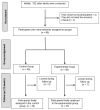Effects of Dance-Based Aerobic Training on Functional Capacity and Risk of Falls in Older Adults with Mild Cognitive Impairment
- PMID: 40869725
- PMCID: PMC12387424
- DOI: 10.3390/jcm14165900
Effects of Dance-Based Aerobic Training on Functional Capacity and Risk of Falls in Older Adults with Mild Cognitive Impairment
Abstract
Background: Older adults with mild cognitive impairment are at increased risk for physical decline and falls due to decreased strength, flexibility, balance, and gait. Dance-based aerobic training has emerged as a promising and enjoyable intervention to promote physical function and cognitive stimulation. This study aimed to evaluate the efficacy of a 12-week structured dance-based aerobic program, based on line dancing and Latin rhythms (e.g., salsa, merengue, and bachata), in improving functional capacity and reducing the risk of falls in older adults with mild cognitive impairment. Methods: A randomized controlled trial was conducted with 92 participants aged ≥65 years diagnosed with mild cognitive impairment. The participants were randomly assigned to an experimental group (dance-based training, twice weekly for 12 weeks) or a control group (usual activity). Outcomes included muscle strength (grip dynamometry), flexibility (back scratch and chair sit-and-reach tests), gait speed (Timed Up and Go test), balance (Tinetti scale), and total falls risk score (Tinetti). Mixed ANOVA and Cohen's d were used for statistical analysis. Results: Significant improvements were observed in the experimental group on all variables compared to the control group. Muscle strength (p < 0.001, d = 0.86), gait speed (p = 0.026, d = 0.48), and upper and lower extremity flexibility (d = 0.43-0.79) improved significantly. The balance and gait components of the Tinetti scale also increased (p = 0.007 and p = 0.048, respectively), as did the total Tinetti score (p = 0.002, d = 0.67), indicating a reduction in the risk of falls. Conclusions: These findings suggest that, under structured conditions, dance-based aerobic training may serve as a promising non-pharmacological strategy to support healthy aging in older adults with mild cognitive impairment, although further validation in larger cohorts is needed.
Keywords: aerobic training; balance; dance; flexibility; mild cognitive impairment; risk of falls.
Conflict of interest statement
The authors declare no conflicts of interest.
Figures










Similar articles
-
Physical exercise for people with Parkinson's disease: a systematic review and network meta-analysis.Cochrane Database Syst Rev. 2024 Apr 8;4(4):CD013856. doi: 10.1002/14651858.CD013856.pub3. Cochrane Database Syst Rev. 2024. PMID: 38588457 Free PMC article.
-
Physical exercise for people with Parkinson's disease: a systematic review and network meta-analysis.Cochrane Database Syst Rev. 2023 Jan 5;1(1):CD013856. doi: 10.1002/14651858.CD013856.pub2. Cochrane Database Syst Rev. 2023. Update in: Cochrane Database Syst Rev. 2024 Apr 08;4:CD013856. doi: 10.1002/14651858.CD013856.pub3. PMID: 36602886 Free PMC article. Updated.
-
Physical exercise training interventions for children and young adults during and after treatment for childhood cancer.Cochrane Database Syst Rev. 2016 Mar 31;3(3):CD008796. doi: 10.1002/14651858.CD008796.pub3. Cochrane Database Syst Rev. 2016. PMID: 27030386 Free PMC article.
-
Interventions incorporating physical and cognitive elements to reduce falls risk in cognitively impaired older adults: a systematic review.JBI Database System Rev Implement Rep. 2016 May;14(5):110-35. doi: 10.11124/JBISRIR-2016-002499. JBI Database System Rev Implement Rep. 2016. PMID: 27532469
-
Falls prevention interventions for community-dwelling older adults: systematic review and meta-analysis of benefits, harms, and patient values and preferences.Syst Rev. 2024 Nov 26;13(1):289. doi: 10.1186/s13643-024-02681-3. Syst Rev. 2024. PMID: 39593159 Free PMC article.
References
-
- World Health Organization . Ageing and Health. World Health Organization; Geneva, Switzerland: 2024. [(accessed on 4 April 2025)]. Available online: https://www.who.int/news-room/fact-sheets/detail/ageing-and-health.
-
- National Research Council (US) Panel on a Research Agenda and New Data for an Aging World . Preparing for an Aging World: The Case for Cross-National Research. National Academies Press (US); Washington, DC, USA: 2001. [(accessed on 5 April 2025)]. The Health of Aging Populations. Available online: https://www.ncbi.nlm.nih.gov/books/NBK98373/ - PubMed
LinkOut - more resources
Full Text Sources
Miscellaneous

